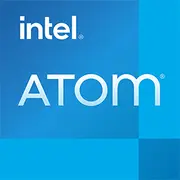Intel Atom D2550

Intel Atom D2550: Outdated but Alive. Who is it Relevant for in 2025?
Introduction
The Intel Atom D2550 processor, released in 2012, is an example of a “long-liver” among mobile chips. Despite its age, devices based on it are still available for sale as ultra-budget solutions (new laptops range from $200 to $250). But should you consider it in 2025? Let's delve into the details.
1. Architecture and Process Technology: What's Inside?
Cedarview: The Era of 32 nm
The Atom D2550 is built on the Saltwell architecture (part of the Cedarview platform) with a 32 nm process technology. It is a dual-core processor with Hyper-Threading support (4 threads). The base frequency is 1.86 GHz, and it lacks a turbo mode.
CPU Features:
- Relative Performance: The cores are optimized for low power consumption rather than high speed.
- Cache: 1 MB L2, which is half of what modern budget Celeron processors offer.
- Instructions: Support for SSE3, but lacks AVX and other modern extensions.
Integrated Graphics
The GPU is a PowerVR SGX545 (operating at 400 MHz), integrated into the NM10 chipset. Since it's not part of the CPU, the graphics capabilities depend on the motherboard. Its capabilities are modest:
- Video playback up to 1080p (with hardware acceleration).
- Gaming: only older titles like Half-Life 2 at minimum settings (10-15 FPS).
2. TDP 10W: Cool and Quiet
Power consumption is the D2550's main advantage. A TDP of 10W allows for passive cooling. This is ideal for:
- Ultraportable laptops (e.g., Chuwi Minibook).
- Mini-PCs for digital signage or terminals.
Real Load:
- Watching YouTube (1080p): 4–6 W.
- At peak load (e.g., running LibreOffice + browser): up to 9 W.
3. Performance: What Can It Handle in 2025?
Office Work
- Google Docs, LibreOffice: Adequate performance for text and spreadsheet tasks, but with limitations:
- Opening Excel files over 10 MB takes 15–20 seconds.
- Working with 5+ tabs in the browser may cause lags.
Multimedia
- Video: 1080p through VLC or MPV is smooth (thanks to GPU decoding).
- Streaming: YouTube at 1080p uses 70–90% of CPU resources.
Gaming
Only retro games and 2D projects:
- Stardew Valley: 30–40 FPS on low settings.
- Terraria: 25–35 FPS.
- Minecraft (version 1.12): 15–20 FPS with OptiFine.
4. Usage Scenarios: Who is It For?
- Students: For note-taking, PDFs, and Zoom (without background filters).
- Office Tasks: Cashiers, mail clients.
- "Secondary" Devices: Information kiosks, media centers for TV.
Categorically Unsuitable For:
- Video/photo editing (even in Lightroom).
- Modern operating systems like Windows 11 (officially unsupported).
5. Battery Life: Myths and Reality
Laptop Runtime
With a battery capacity of 40 Wh:
- Web surfing: 6–7 hours.
- Video playback: 8–9 hours.
Power-Saving Technologies:
- Enhanced SpeedStep: Reduces frequency to 800 MHz at idle.
- C-states: Disables unused CPU blocks.
Advice: For maximum battery life, choose models with SSDs (not HDDs) and IPS screens with matte finishes (brightness 200 nits).
6. Comparison with Competitors
AMD E-350 (2011):
- Weaker in multi-threading (214 vs. 180 in Geekbench 6 Multi).
- However, its Radeon HD 6310 graphics are better (can handle Left 4 Dead 2 at 20 FPS).
Intel Celeron N4020 (2019):
- 2.5 times faster in single-threaded tasks.
- TDP of 6W, supports Windows 11.
Apple M1 (2020):
- Comparing is pointless: M1 is 10 times more powerful at a similar TDP.
7. Pros and Cons
Strengths:
- Price of laptops: $200–250.
- Silence (passive cooling).
- Linux support (e.g., Lubuntu runs "like clockwork").
Weaknesses:
- No support for DDR4, NVMe, USB 3.0.
- OS limitations: Windows 10 is the maximum.
8. Recommendations for Choosing a Laptop
Types of Devices:
- Ultra-Budget Laptops: For example, HP Stream 11 (new models for 2024–2025 start at $220).
- Mini-PCs: Used as media players (e.g., MeLE Quieter3).
What to Look For:
- Screen: 1366x768 resolution is outdated, but sufficient for basic tasks.
- Storage: Definitely SSD (even 64 GB), otherwise performance will drop by 2–3 times.
- Ports: Look for HDMI and USB-C (rare for such devices).
9. Final Conclusion: Who Should Buy?
The Atom D2550 in 2025 is a choice for those who:
- Are looking for a cheap device for text and internet use.
- Value silence and long battery life.
- Are willing to accept limitations (for example, installing Linux instead of Windows).
Alternatives: If your budget allows for $300–400, consider laptops with Intel N100 or AMD Ryzen 3 7320U—they are significantly more powerful with similar TDP.
Conclusion
The Intel Atom D2550 is an archaic but alive processor. It has found its niche in a world where even $200 is a significant sum. It’s not a choice for the future, but a workable option for the present, where basic tasks are sufficient.
Basic
CPU Specifications
Memory Specifications
GPU Specifications
Benchmarks
Compared to Other CPU
Share in social media
Or Link To Us
<a href="https://cputronic.com/cpu/intel-atom-d2550" target="_blank">Intel Atom D2550</a>